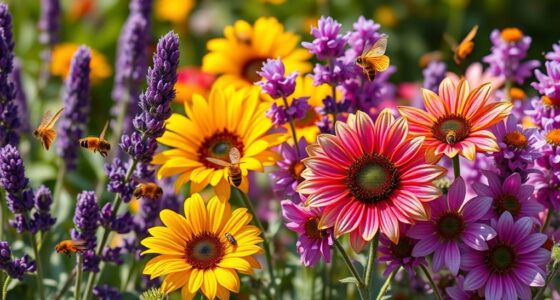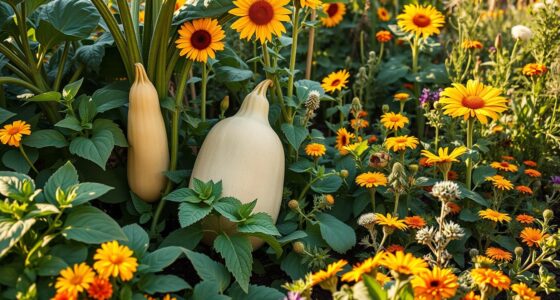As you step into your garden, feeling the earth between your fingers, there’s something uniquely rewarding about nurturing plants that yield a bountiful harvest. Growing bush beans can transform your gardening experience, not just because of their delectable taste, but due to the magic that unfolds when you combine them with the right companions. The camaraderie of bush bean companion plants can enhance their growth, deter unwanted pests, and ultimately lead to a flourishing garden. Imagine harvesting vibrant beans, knowing that the synergy with your selected plants has made your garden a bustling ecosystem of life. Whether you’re a seasoned gardener or a beginner, exploring the best companions for bush beans will make your gardening journey enriching and enjoyable. So let’s dive into these organic bush bean companion plants and see how companion planting suggestions for bush beans can elevate your gardening adventure.
Key Takeaways
- Bush beans thrive alongside certain plants that enhance their growth.
- Companion planting can help deter pests naturally.
- Organic bush bean companion plants promote soil health.
- Understanding plant relationships increases garden productivity.
- Choosing the right companions can lead to improved flavors in harvests.
What Are Bush Beans?
Bush beans offer a wonderful addition to any home garden. Known for their compact growth, these beans typically reach heights of 1-2 feet and thrive in a bushy form rather than climbing like their pole bean counterparts. You might wonder, what are bush beans? They belong to the common bean species, Phaseolus vulgaris, and are praised for their ease of cultivation and relatively short maturation period. This makes them a favorite choice among gardeners seeking a reliable crop.
Overview of Bush Beans
Bush bean characteristics include their determinate growth pattern, meaning they produce beans all at once before dying back. This characteristic allows for a more manageable harvest, making them ideal for gardeners with limited space. Furthermore, bush beans tend to be easier to care for and require less staking than climbing varieties.
Nutritional Benefits
When considering bush bean nutrition, you’ll find that these legumes are rich in essential nutrients like protein, fiber, vitamins, and minerals. A serving of cooked bush beans contains vital nutrients such as folate, iron, and potassium. The health benefits of bush beans extend beyond just nutritional content; their high fiber levels contribute to digestive health and help maintain healthy blood sugar levels.
Types of Bush Beans
You have various options when it comes to selecting bush beans for your garden. Types of bush beans can range from the classic green beans to yellow wax beans and even vibrant purple beans. Each variety boasts unique flavor profiles and requires specific growing conditions, allowing you to tailor your garden to suit your culinary tastes.
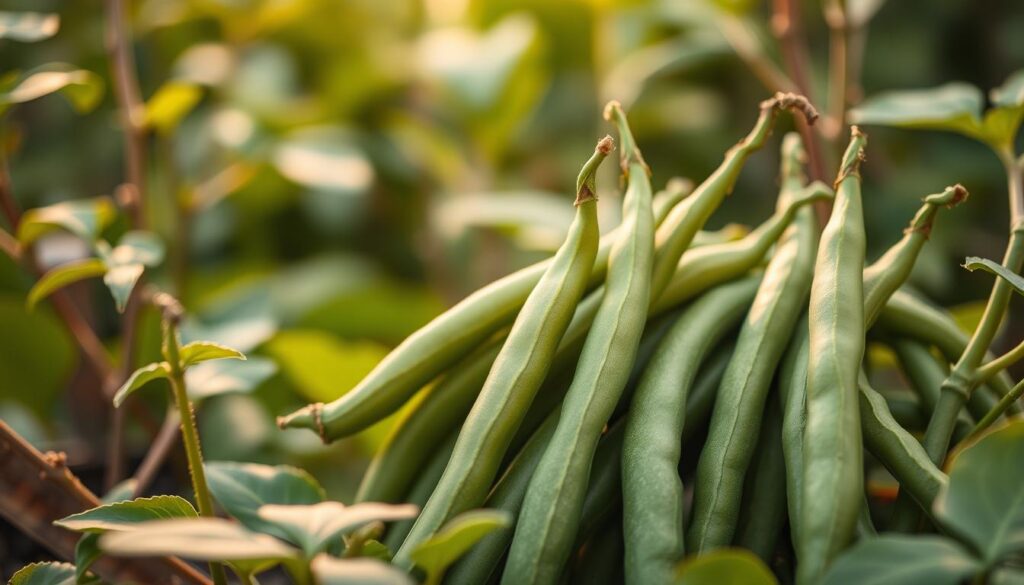
Why Use Companion Planting?
Companion planting is a strategic approach to gardening that pairs different plants together for mutual benefits. This method fosters a natural synergy, enhancing growth and promoting overall vitality in your garden. Understanding the fundamentals of companion planting opens up a world of advantages, particularly when growing bush beans.
Understanding Companion Planting
This practice revolves around the idea that certain plants, when grown close to each other, can support one another in various ways. By leveraging natural ecosystems, you can create a diverse garden that not only flourishes but also minimizes the need for chemical interventions. The benefits of companion planting extend beyond mere aesthetics, influencing growth rates, pest control, and even biodiversity.
Benefits for Soil Health
Improving soil health stands out as one of the most important companion planting benefits for soil. Certain plants enrich the soil by fixing nitrogen, which is crucial for plant growth. For example, legumes like bush beans enhance nitrogen levels, which can significantly benefit surrounding plants. As a result, you will see improved plant vigor, leading to healthier yields.
Pest Control through Companions
Effective pest management is another major advantage of companion planting. Incorporating insect-repelling plants can deter harmful insects that might threaten your bush beans and other crops. For instance, marigolds are known for their ability to repel pests such as aphids and Mexican bean beetles. By creating a balanced ecosystem, you not only protect your crops but also bolster overall garden health.
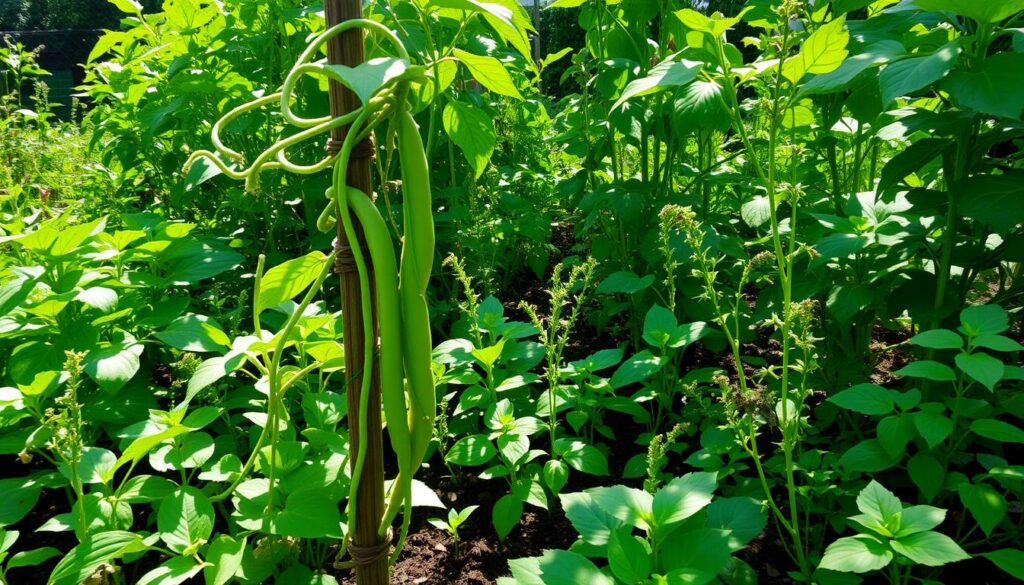
Ideal Companion Plants for Bush Beans
Choosing the best companions for bush beans can significantly enhance your garden’s productivity and flavor. These plants work harmoniously, creating a thriving ecosystem that benefits each other. Below, explore the top choices for bush bean companionship and the advantages they provide.
Top Choices for Bush Bean Companionship
When considering bush bean garden companions, several plants stand out:
- Corn: Provides natural support for climbing beans while utilizing different soil layers, minimizing nutrient competition.
- Squash: Benefits from the nitrogen produced by bush beans, promoting healthier growth for both crops.
- Cucumbers: Thrive in similar conditions as beans, making them efficient in utilizing garden space and nutrients.
Short Growing Season Companions
If you’re focusing on short season planting, pairing bush beans with quick-growing companions like:
- Radishes: Mature quickly, allowing for harvesting before the bush beans reach full growth.
- Lettuce: Grows rapidly, maximizing garden area and providing fresh greens alongside beans.
Flavor Enhancement from Companions
Companion plants can enhance flavor, adding depth to your harvest. For instance, growing bush beans with:
- Basil: Creates a delightful synergy that can boost the taste attributes of beans.
- Dill: Known for its unique flavor, this herb also contributes to the companion plants flavor benefits, resulting in richer harvests.

Vegetables That Pair Well with Bush Beans
When planning your garden, consider the vegetables that complement bush beans. The right companions can enhance growth and flavor while promoting a healthy ecosystem in your garden. Here’s a look at three standout companions that work wonderfully with bush beans.
Corn: The Perfect Partner
Corn and bush beans thrive together in a gardening technique known as corn bean planting. Corn acts as a natural support for the climbing beans, allowing them to grow higher and access more sunlight. This partnership is part of the classic “Three Sisters” planting method, where each plant supports the others. As bush beans enrich the soil with nitrogen, corn benefits with stronger growth, making this pairing both practical and beneficial.
Squash: Synergy for Success
Companion planting squash and beans brings about wonderful results. The broad leaves of squash shield the soil, helping retain moisture and suppress weeds, creating a more favorable environment for bush beans. Beans squash compatibility lies in the nitrogen contributions from beans, which enhances the nutrient quality of the soil for both crops. Together, they create a thriving micro-ecosystem that yields healthy harvests.
Tomatoes: Flavor and Growth
Tomatoes and bush beans form another effective gardening alliance. This duo not only complements each other’s growth needs but also increases overall yields. The nitrogen fixed by bush beans directly benefits tomato plants, helping them flourish. Additionally, the flavors of these two vegetables marry beautifully, making them a popular choice in culinary applications. Utilizing companion planting tomatoes with bush beans will bring your garden to life.
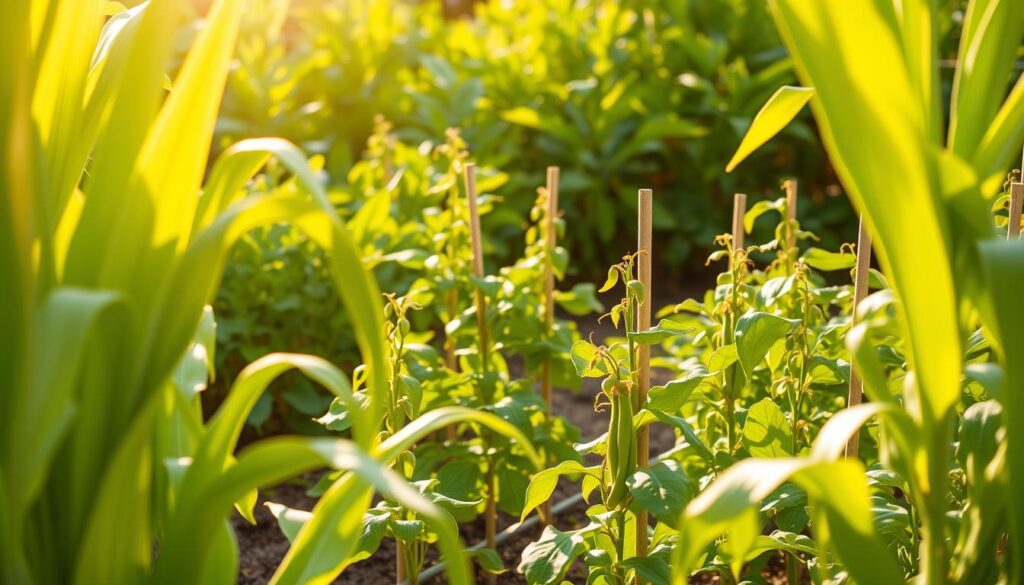
Herbs That Enhance Bush Bean Growth
Growing companion herbs alongside your bush beans can significantly boost their growth and health. These herbs provide benefits ranging from attracting beneficial insects to deterring pests, making them excellent choices for your garden. Let’s explore the advantages of three popular herbs: basil, dill, and cilantro.
Basil: Aromatic Allies
Basil is well-known for its culinary uses, but its role in basil companion planting is equally valuable. This herb not only flavors your dishes but also protects bush beans by repelling pests like aphids. Both plants thrive in similar soil and sunlight conditions, making them ideal companions in your garden.
Dill: Attracting Beneficial Insects
Dill offers impressive dill benefits when planted near bush beans. Its umbrella-shaped flowers attract beneficial insects, such as ladybugs, which prey on common pests that threaten your beans. By incorporating dill into your garden, you enhance biodiversity, creating a more resilient ecosystem that supports healthy bean growth.
Cilantro: Companion for Flavor
Cilantro is more than just a flavorful addition to meals; its cilantro planting benefits for bush beans are noteworthy. By planting cilantro nearby, you not only attract beneficial insects but also elevate the flavor profile of your bean harvest. These flavored companions work harmoniously, providing both culinary enhancement and pest protection.

Flowers That Attract Pollinators
Incorporating flowers into your garden can significantly benefit your bush beans by attracting essential pollinators and enhancing the overall garden ecosystem. Selecting the right companion flowers allows you to create a vibrant garden while promoting healthier yields through improved plant interactions. Here are three standout options that excel in this role.
Marigolds: Pest Deterrents
Marigolds for pest control are a gardener’s favorite. These bold flowers effectively repel unwanted pests such as nematodes and bean beetles. Their striking colors not only make them visually appealing but also contribute to a healthier bush bean garden. You will appreciate how marigolds enhance the overall plant health, serving as a natural shield for your crops.
Sunflowers: Tall Support
Sunflowers companion planting serves a dual purpose. Their impressive height can provide support crops for climbing varieties of bush beans, allowing them to flourish and climb gracefully. Additionally, sunflowers attract pollinators, adding to the dynamic energy of your garden. Their cheerful presence lifts the spirits of both plants and gardeners alike.
Cosmos: Colorful Companions
Cosmos are not just visually stunning; they are also effective in attracting pollinators like bees and butterflies. As you plant cosmos and beans together, you create a symbiotic relationship that promotes improved pollination. These lovely flowers enrich your garden by providing essential nutrients to the ecosystem, resulting in healthier bush bean plants and better yields.
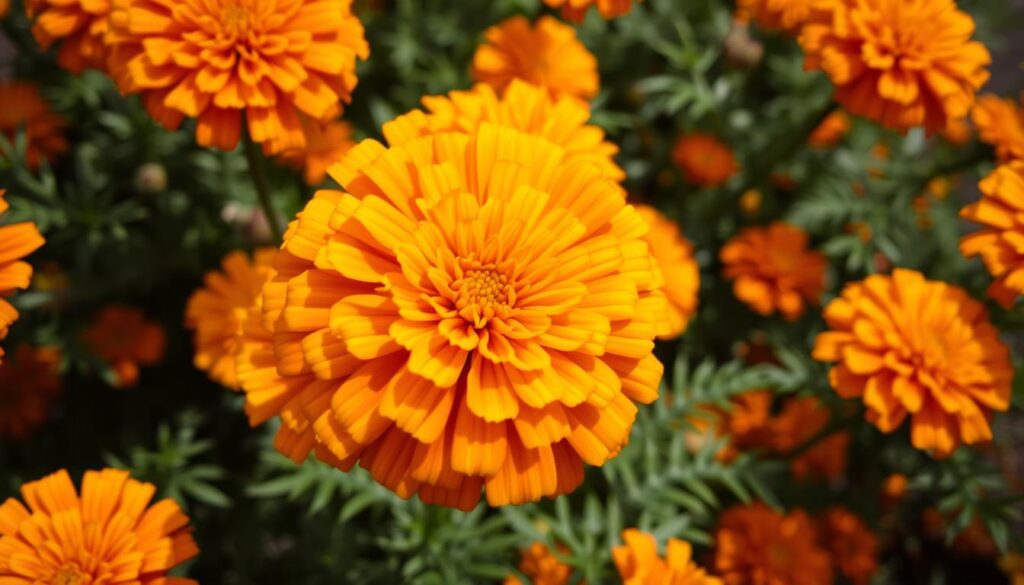
| Flower | Benefits | Best Pairing |
|---|---|---|
| Marigolds | Pest control, vibrant colors | Bush beans |
| Sunflowers | Tall support, attracts pollinators | Climbing beans |
| Cosmos | Attracts pollinators, colorful display | Bush beans |
Avoid These Plants with Bush Beans
Planting your bush beans can be a rewarding experience, but understanding which plants to avoid with bush beans is crucial for maximizing their growth potential. Certain negative companions can seriously hinder the success of your beans, leading to companion planting challenges.
Negative Companions
Be mindful of the following negative companions that can impair the development of your bush beans:
- Onions
- Garlic
- Peppers
- Beets
- Sunflowers
Each of these incompatible plants has specific traits that negatively impact bush beans. For instance, members of the allium family, including onions and garlic, can deter nitrogen-fixing bacteria that are essential for bean growth.
Why Certain Plants Don’t Mix
Understanding why certain plants do not mix is key to successful gardening. Plants like peppers and beets tend to compete for nutrients and space, which can disrupt their growth. Their varying root depths create additional conflicts, leading to less-than-ideal growing conditions for your bush beans.
To cultivate a thriving garden, research the interactions among plants. This practice will help you identify incompatible plants that may pose challenges, ensuring a harmonious garden environment.

Soil Preparation for Bush Beans
Successful bush bean growth begins with proper soil preparation. Quality soil for planting supports robust root systems and healthy plants. When you create an ideal environment for your beans, you can expect a bountiful harvest. Focus on enriching soil health through appropriate amendments and maintaining the right pH levels to ensure optimal growth.
Importance of Soil Quality
Quality soil for planting is vital for bush beans. Well-draining soil that retains moisture while allowing adequate aeration promotes healthy root development. Improving soil health can involve incorporating organic matter, which enhances soil structure and increases nutrient content. Consider incorporating aged compost or well-rotted manure to provide a nutrient-rich foundation for your beans.
Recommended Soil Amendments
By using specific soil amendments for bush beans, you help create a thriving ecosystem for your plants. Some beneficial amendments include:
- Aged compost
- Well-rotted manure
- Green manure crops
- Bone meal or fish emulsion for additional nutrients
These amendments contribute to soil fertility, fostering beneficial microbial activity essential for bush bean growth.
pH Levels for Optimal Growth
Maintaining the proper soil pH for bush beans is critical. Beans thrive best in soil with a pH level between 6.0 and 6.8, which falls within the slightly acidic to neutral range. Testing your soil pH allows you to adjust conditions, ensuring the best nutrient availability. The pH level importance cannot be overstated, as it directly affects plant health and yield potential.

Watering and Care for Bush Beans
Proper care is vital for bush beans to thrive and produce a bountiful harvest. This involves effective watering techniques, mulching practices, and regular maintenance routines that ensure your plants receive everything they need. Explore these essential bush bean care tips to help you cultivate healthy, robust plants.
Best Practices for Watering
Watering bush beans consistently is crucial for their growth. During periods of dryness, aim for deep watering to promote a healthy root system. Consider the following irrigation techniques:
- Water early in the morning to reduce evaporation.
- Use drip irrigation for efficient moisture delivery.
- Avoid wetting the leaves to lower the risk of diseases.
Mulching Techniques
Implementing effective mulching for beans can greatly enhance soil health. The benefits of garden mulch include moisture retention, weed suppression, and temperature regulation. Choose organic materials like:
- Wood chips
- Straw
- Grass clippings
As these materials break down, they enrich the soil, providing additional nutrients for your beans.
Regular Maintenance Tips
Garden maintenance goes beyond watering and mulching. Consistent monitoring is essential for optimal growth. Consider these practices:
- Regularly check for pests and take action promptly.
- Keep the area around the plants free of weeds.
- Ensure sufficient sunlight exposure by pruning overgrown plants.

Harvesting Your Bush Beans
Knowing the right time for bush bean harvesting enhances the flavor and quality of your crops. You want to collect the beans when the pods are firm and slightly tender, usually when they are about 4 to 6 inches long. Regular harvesting not only ensures a delicious outcome but also encourages continued production for the rest of the season.
When to Harvest
The optimal harvest time for bush beans typically occurs when the pods have matured but are still young. Checking them regularly will help you spot the perfect moment to harvest and maximize bean yield. Aim to collect your beans when the pods are still green and firm, yet not overripe or dried out.
Techniques for Best Yields
Employing effective harvesting techniques preserves both the plants and the quality of the beans. Use scissors or garden shears to cut the pods from the stem gently. This method allows for regrowth while preventing any damage to the surrounding plants, ensuring the longevity of your bush beans throughout the growing season.
Post-Harvest Care
After harvesting, your attention shifts to post-harvest care for beans. Store bush beans in a cool environment or refrigerate them to maintain their freshness. Proper handling during this phase is crucial, as it enhances flavor retention and prolongs the shelf life of your beans. Implementing smart storage tips will ensure your harvest stays delightful until you’re ready to enjoy them.

Fertilization Strategies for Bush Beans
Effective fertilization is essential for optimizing the growth and yield of your bush beans. Utilizing the right organic fertilizers for beans and a well-planned fertilization schedule can greatly enhance bush bean health. Understanding when to fertilize bush beans and recognizing nutrient deficiency indicators will ensure your plants thrive.
Organic Options for Nutrient Boost
Choosing organic fertilizers is a preferred method for providing necessary nutrients during the growing season. Options like fish emulsion and well-aged manure offer a rich source of nutrients while promoting a healthy soil ecosystem. These fertilizers minimize the risk of chemical build-up and foster long-term soil fertility, giving a natural boost to your plants.
Timing Your Fertilization
Developing a proper fertilization schedule is crucial. Fertilizing at planting time lays the groundwork for initial growth, while a second application during blossoming supports pod development. These nutrient strategies align with the bush bean growth stages, maximizing their potential for producing a bountiful harvest.
Signs Your Beans Need More Nutrients
Monitoring your bush beans for nutrient deficiency indicators can significantly enhance their health. Look for yellowing leaves, stunted growth, or poor pod formation as signs that they may require additional nutrients. Adjusting your fertilization approaches according to these symptoms strengthens plant vitality and encourages productivity.
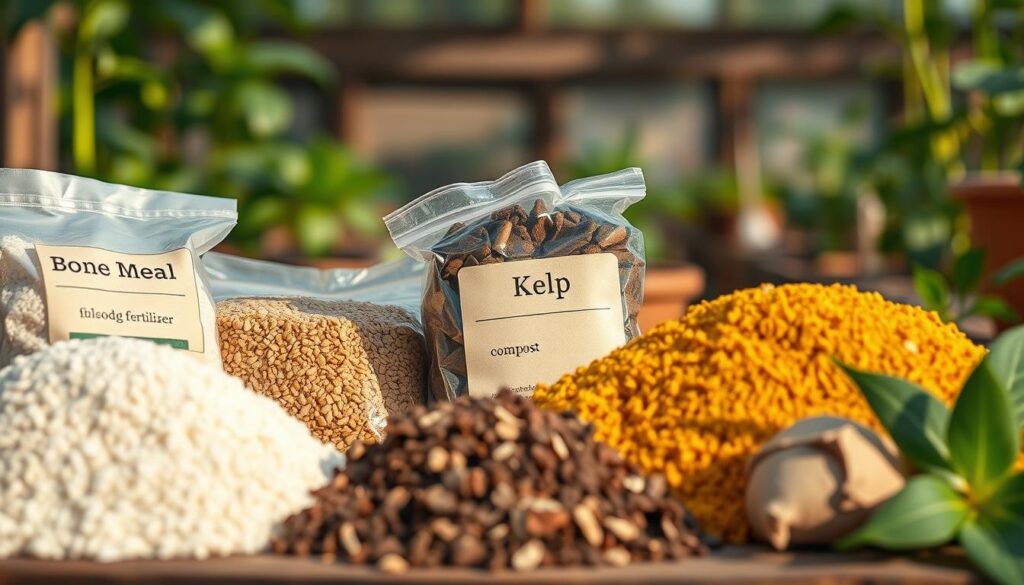
Pest Management Techniques
Keeping beans healthy involves a proactive approach to pest management for beans. Identifying common bush bean pests early can make a significant difference. Understanding their behavior and lifecycle aids in effective pest control, ensuring your harvest thrives.
Common Pests to Watch For
Pay attention to these frequent invaders that can threaten your bush bean crop:
- Aphids: These tiny insects suck sap from leaves, leading to wilting and stunted growth.
- Mexican Bean Beetles: Recognizable by their yellow-orange color, they damage foliage and can decimate your plants if not controlled.
- Spider Mites: These pests create fine webbing on your plants and cause leaf discoloration.
Natural Remedies for Pests
Natural pest control methods can effectively combat these threats while maintaining a healthy garden ecosystem. Consider these organic pest remedies:
- Insecticidal soap: A straightforward solution that kills aphids and other soft-bodied insects.
- Neem oil: Derived from the seeds of the neem tree, it disrupts the lifecycle of various pests.
- Companion plants: Certain plants naturally repel pests, enhancing the overall health of your beans.
Preventative Measures
Effective pest prevention strategies lay the groundwork for a thriving garden. Implement these methods:
- Crop rotation: Changing the position of your bean crops each season helps disrupt pest patterns.
- Intercropping: Planting beans alongside pest-repelling plants can create a natural barrier against infestations.
- Maintaining garden cleanliness: Regularly clear debris and plant residue to eliminate hiding spots for pests.

Seasonal Considerations in Companion Planting
Understanding the seasonal needs of bush beans can enhance your gardening strategy. Proper attention to spring planting tips, summer care for beans, and fall harvesting strategies will ensure a thriving crop throughout the year.
Spring Planting Guide
Start your growing season by carefully timing for bush beans. Aim to plant them once the last frost has passed and soil temperatures consistently rise above 60°F. This optimal timing fosters healthier growth. Consider incorporating interplanting methods, such as pairing bush beans with fast-growing varieties like radishes. This approach maximizes garden space and yields.
Summer Maintenance Tips
During the summer months, maintaining bush beans requires diligent care. Regular watering is essential to support healthy growth, especially in warmer weather. Establish support systems to aid bean plants’ growth, promoting vertical expansion. Monitor for pests and provide shade during heat waves to prevent stress on your plants. Implementing these summer care for beans practices will contribute to a bountiful harvest.
Fall Harvesting and Cover Crops
As fall approaches, timely harvesting becomes crucial. Engage in effective fall harvesting strategies by collecting ripe beans before the first frost hits your garden. After harvesting, planting cover crops offers numerous benefits. Consider options like clover, which enhance soil health and structure, paving the way for future planting cycles. Utilizing cover crops benefits your soil, fostering a sustainable gardening practice.
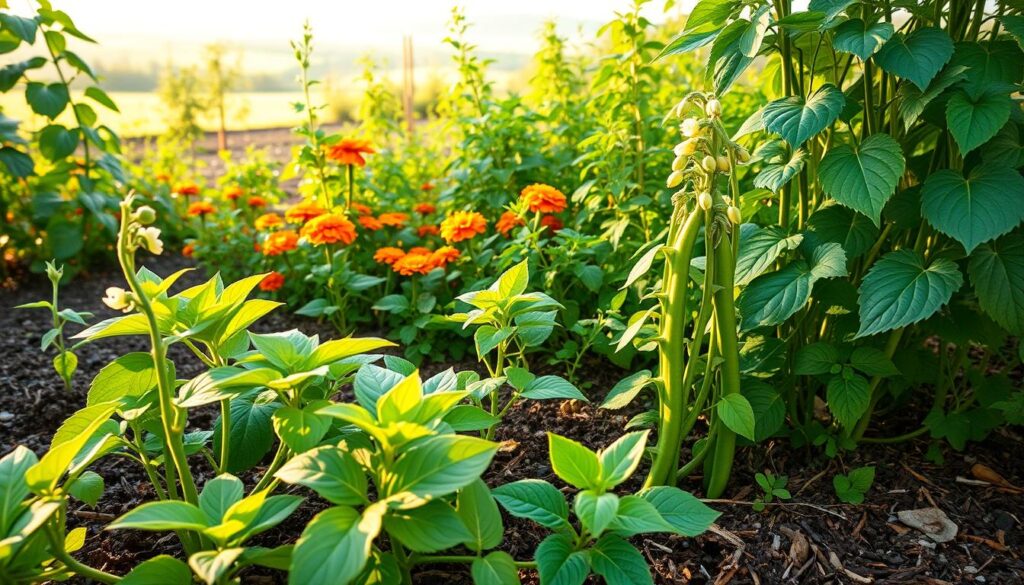
Conclusion: Grow a Thriving Garden
As we wrap up this exploration, the benefits of companion planting become clear. By strategically pairing bush beans with compatible plants, you can enhance garden productivity, improve pest resistance, and enrich soil health. These natural partnerships not only yield bountiful harvests but also create a more vibrant ecosystem within your garden.
Don’t shy away from gardening experimentation. Take the initiative to mix and match different companion plants, as this ongoing journey of exploring companion planting will lead you to discover pairings tailored to your specific garden conditions and aesthetic desires. Every unique combination can bring new surprises and rewards to your gardening experience.
Implementing the insights from this article will empower you with essential gardening success tips. Embrace step-by-step gardening methods, keep a watchful eye on your plants’ health, and proactively address any pest challenges. With these strategies, you will cultivate a splendid bush bean garden that thrives all season long, providing you with the joys of homegrown produce.



